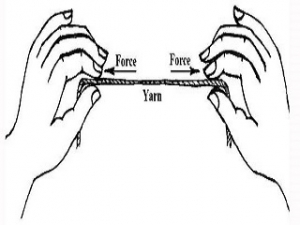
Yarn stretching plays an important role in weaving and fabric production, and has a significant impact on the efficiency of various processes such as yarn spinning on the spool, yarn twisting and yarn splicing. Proper yarn tension is required to produce suitable yarn packages, warp yarn spools, to produce weft yarn packages and to wrap yarn on weft tubes or spools for use in knitting machines to weave the fabric.
Yarn tension means the tensile stress that occurs when the yarn is exposed to external tensile strain. Therefore, the amount of yarn tension depends on the external strain. Stress is expressed in grams or Newtons. More tension of the yarn leads to tighter packaging of the yarn and vice versa.
Yarn stretching in the preliminary stage of weaving
In the tissue preparation stage, yarn stretching is necessary for various reasons. In the spinning process, the spun yarn is wrapped around a spool to prepare the yarn package with the desired shape and size and with the necessary density. If a suitable amount of tension is applied to the yarn during the spinning process during the spinning process, a suitable yarn package will be produced. Proper shape and stability of the yarn packaging makes the yarn easy to open in the next steps and can withstand the packaging during transportation without loosening.
In the weaving preparation stage, the warp or weft yarns are first opened from the same packages and then repacked in different molds two or even three times before they become ready-made packages for the knitting machine. (Or wrapped in various tubes). While opening the yarn from the package, the yarn is stretched due to inertia; Now what happens to the package that the yarn comes out of by spinning and the yarn that comes out of the fixed package.
To make yarn bundles with the required shape, size, and degree of stability, the yarn must be re-wrapped around other tubes and must be under constant tension during this process. In addition, the yarn is usually subjected to some stretching during the initial stages of weaving; This will eliminate some of the thread defects (such as weak spots). The amount of yarn tension is adjusted based on the grade and tensile strength of the yarn so that it is torn in weak places, but the yarn is not stretched enough to lose its elasticity. The tensile properties of opening the yarn from the package depend on factors such as the opening speed of the yarn, the size of the package, the height of the balloon, the grade of the yarn, the type of stretching machine used, and so on.
The role of yarn tension in fabric texture
The factor that plays the most vital role among the various stages of textile processing from spinning to weaving is yarn stretching. In order for the fabric weaving operation to function properly, the tension of the warp yarns is necessary for the correct formation of the warp yarn opening; Because weaving threads are supposed to be placed in it. In addition, the tension of the yarn is important for other reasons, because it is the yarn that must keep the fabric in a proper position and prevent it from falling in order to weave the fabric in the form of predetermined intervals. High-density fabrics require more yarn tension, while loose fabrics require less yarn tension to meet tissue requirements. The tension of the weft yarn helps to eliminate the looseness and torsion of the weft yarn when it is placed in the opening of the warp yarn and causes the weaving to take place at the desired distances. Since warp and weft yarns need to be woven together to form a fabric, the tension of the yarns due to their complexity determines the amount of wrinkles applied to the set of two yarns, which in turn affects the properties of the resulting fabric. Affect.
Therefore, yarn tension is one of the most important parameters in different stages of textile processing. Yarn tension in each of the processing steps has a significant impact on the performance and efficiency of the machines and the quality of the products made. Always try to keep the yarn tension as low as possible for certain purposes during processing and keep this level of yarn tension constant during the process. It is also best to keep the yarn tension as uniform as possible during the process. Excessive yarn tension or excessive changes in it can cause the yarn strain to be too high, which can lead to yarn breakage, which in turn reduces the efficiency of the machines and the quality of the product.











Leave a Reply
Want to join the discussion?Feel free to contribute!